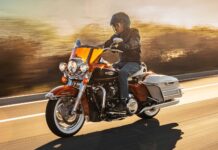
If you’ve been sleeping (or in Hawaii, or hungover, or both) during the last couple of years, you might have missed the fact that there’s a lot going on in Milwaukee. Aside from some new (albeit traditional) Harleys on the scene, such as the return of the Low Rider and some high-horsepower baggers, there’s a ton of new two-wheeled stuff percolating just below the surface of Juneau Avenue. Harley announced some of this months ago (electric bikes and bicycles, including the amazingly functional LiveWire) and some just recently at the early-November EICMA show in Milan.
It’s this Milan-show stuff that’s got me buzzin’, along with a lot of the moto public that pays attention to such things. The Harley folks had teased some of these concepts over the last 18 months, with prototype images and engine photos and such, and for a whole lot of reasons – current market demographics, downward-sliding sales numbers, the health of some genres Harley wasn’t in and the idea that Harley-Davidson had to expand into some of them if it was to survive – you just knew it wasn’t bluster. And it wasn’t.
The concept bikes I’m referring to, which are to appear in 2020 as 2021 models, are an adventure tourer called Pan America and a naked streetfighter called Bronx. Both are about as technologically advanced as you can get on the streetbike side, and when you’re talking about a Milwaukee-minted product that uses internal combustion for go-power (and not a battery), that’s really saying something.
Each is powered by a thoroughly modern and totally new modular engine, one in 1250cc displacement (for the Pan America) and a second in a 975cc size for the Bronx. Basic engine architecture – liquid-cooling, four valves per cylinder, 60-degree vee angle, fuel injection, etc. – is same-same for each, and you’ve gotta imagine these powerplants will find their way into other models in other genres going forward – which opens up a whole lotta territory for Milwaukee to occupy.
Above and beyond naked sporty bikes and adventure touring bikes, you’ve got the possibility of new-generation cruisers, performance cruisers… and maybe even that Vance & Hines dirt track replica I – and thousands of like-minded enthusiasts – have been lusting after and hoping for for decades. (One that looks like the factory racebikes, please. It can be done!) All of these, of course, would pack top-shelf and class-standard (or, better yet, class-leading) power, weight and handling. Which would satisfy the naysayers out there.

This genre-expansion is a new thing for Harley-Davidson, for sure, though it’s something the company will need to do as boomers continue to become less and less of a buying force, and (largely) risk-averse Gen Xers and Millennials continue to eschew motorcycling in large numbers. It’s all part of the More Roads To Harley-Davidson thing Milwaukee is pushing, which realizes “a fast-changing world with new consumer demands” and the need to “inspire future riders who have yet to even think about the thrill of riding.”
Aside from all that, the Bronx and Pan America should generate tons of discussion and excitement. And from what I hear, they’re exceptionally capable in a dynamic sense, too, and ‘right there’ with the competition. I’d heard the same thing regarding the LiveWire’s handling and power and fun factor, and it wasn’t a lie, so I’m thinking these two are gonna be damn good. But we shall see.
All of this ‘new genre’ talk and movement reminds me of the push by Harley-Davidson (and partner Porsche) during the later ’70s and very early ’80s with the Nova-project prototypes, designed to put Milwaukee squarely in the middle of the ongoing tech war being waged between the Japanese. A lot of folks think abandoning that effort (which happened shortly after the AMF buy-back) was a mistake, but I disagree. I believe following that V-Four route might have spelled the end of the Motor Company as we know it, especially given how fragile it was financially directly after the buy-back. Beals and Co. were smart to abandon the effort and concentrate on what they knew and did best. History seems to prove that.
But this time it’s different. And it should be fun to watch, for sure.



















